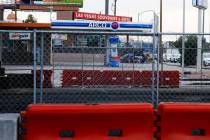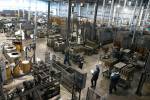Census shows long-distance moves at record low
WASHINGTON -- Americans are shunning long-distance moves at record levels as many young adults, struggling without jobs, opt to stay put rather than relocate to other parts of the United States.
It's a trend with important implications for Las Vegas, which has long relied on strong population growth to power a local economy dependent on new construction and consumer spending.
Depending on which numbers you look at, the Las Vegas Valley's population has either flattened or fallen as much as 2 percent in the last two years, noted Brian Gordon, a principal in local research and consulting firm Applied Analysis.
"The reality is that people are tethered to their homes. Many properties, both in Southern Nevada and across the country, are underwater, so homeowners' ability to quickly relocate is somewhat limited," Gordon said.
What's more, relocating residents typically cite job opportunities as the top factor impelling them to move. But fresh jobs are tough to come by both in Las Vegas and elsewhere. That means fewer incentives to decamp, Gordon said.
The new information from the Census Bureau highlights the extreme pressure the sluggish economy is putting on people in this country, especially those in some of the hardest-hit groups.
"It is truly a Great Depression for young adults," said Andrew Sum, an economics professor and the director of the Center for Labor Market Studies at Northeastern University in Boston. "Young adults are working at lower rates than they ever worked before since World War II. As a result, you would expect migration to fall because they have nowhere to go to."
The share of longer-distance moves across states fell to roughly 4.3 million people, or 1.4 percent, down from 1.6 percent in 2009. It was the lowest level since the government began tracking movers in 1948.
Among adults ages 25-29, about 3.2 percent moved to a new state last year, down from 3.7 percent. Moving rates for college graduates, who historically are more likely to relocate out of state, remained flat at a low of 2.1 percent. Moves by those lacking a college degree dipped slightly.
William H. Frey, a demographer at Brookings Institution who analyzed the data, noted that cities seeing relative gains were the handful that offered the promise of specialized tech jobs and hip lifestyles to more educated, young professionals.
"It is clear the weak economy continues to keep young people, especially college grads, locked down, unable to move to jobs, buy homes and start families," he said. "Many are hunkering down at home, or in so-called 'cool cities' until both the job and housing markets improve."
New York and Los Angeles were among larger cities seeing fewer losses as many younger people stayed put, according to 2007-2009 census data released Tuesday. Metro areas with diversified economies such as Austin, Texas; Raleigh, N.C.; and Portland, Ore., saw gains in college graduates relative to other cities.
Other metro areas seeing new gains or reduced migration losses among college graduates were San Francisco; San Diego; Boston-Cambridge, Mass.; and Washington, D.C.-Arlington, Va. All have burgeoning biotech industries and are home to several major universities.
Large metropolitan areas in Sun Belt states continued to attract some young adults but at a slower pace. Compared to earlier in the decade, migration dropped in Phoenix; Las Vegas; Orlando, Fla.; and Riverside, Calif., as many people were locked in place due to a housing crunch and souring job market.
But don't expect Las Vegas to lag forever, Gordon said.
The region hasn't relied merely on the young or the college-educated for growth, attracting instead a "broad demographic spectrum" of new residents ranging from young families to career-age adults to retirees.
Retirees, in particular, will continue to gravitate toward Southern Nevada, because they're less dependent on the job market and because housing has become so affordable here. And as the overall economic climate improves and job growth revives, the city is likely to see a new mix of potential employees arrive, Gordon said.
Overall, 12.5 percent of the U.S. population, or more than 38 million people, made some kind of move to a new home, a figure that is unchanged from 2009, according to new census figures. Only in 2008 was the overall mobility rate lower, at 11.9 percent.
Only moves within counties edged higher. That often is a sign that renters or lower-income people were relocating nearby due to foreclosures or to "double up" with friends or family, say analysts of the data. The percentage of people in the U.S. who moved within the same county rose from 8.4 percent in 2009 to 8.7 percent.
Gordon said that trend is likely even greater in Las Vegas, which has long housed a bigger-than-average share of cross-town movers.
When the real estate market peaked from 2004 to 2006, locals moved up and around rapidly, with renters scooping up new homes and existing homeowners trading up to higher-end suburbs at the edge of the valley, Gordon said.
Now, the reverse is happening, as homeowners who can no longer afford their mortgages have been forced to downsize.
"We've seen these kinds of in-market changes on both the upside and the downside," Gordon said.
Review-Journal writer Jennifer Robison contributed to this report.























